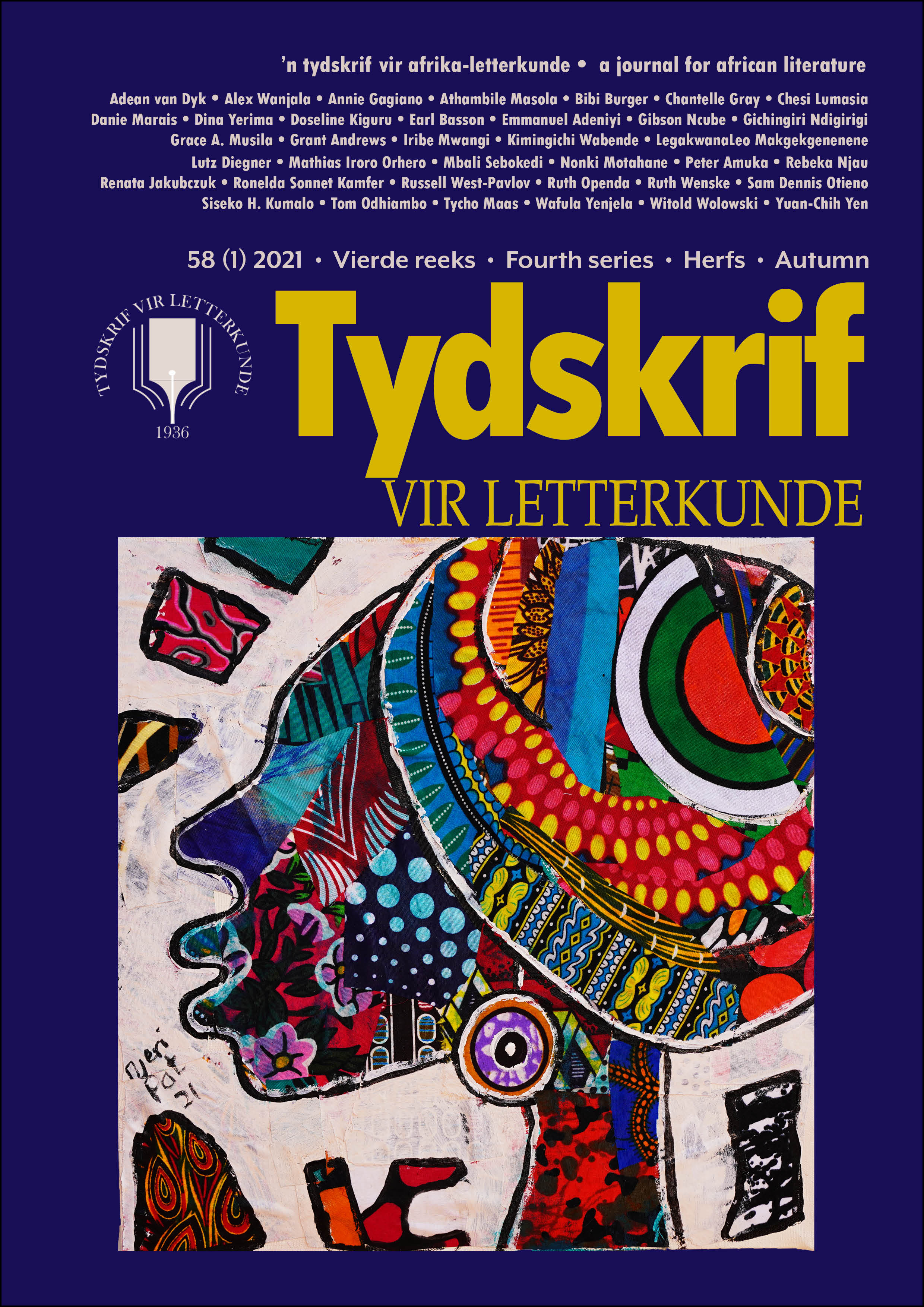Churchill Show: Transgressing language codes and upsetting stereotypes
DOI :
https://doi.org/10.17159/tl.v58i1.8256Mots-clés :
Churchill Show, aesthetics of escapism, transglossia, political aesthetics, postmodern humour, ‘Kenyanness’Résumé
Cultural productions on television and/or online platforms are immensely prolific at expressing the peoples’ every day and the historical. They provide platforms on which actors express themselves on their own terms, in their own language codes and styles with little censure. With the proliferation of digital technologies and the advent of the internet and attendant new media, the production, circulation, and consumption of cultural texts on the (Eastern) African scene has radically shifted and continues to grow in ways unimagined before. In Kenya specifically, with an exponential growth of television channels, numerous local cultural productions continue to burgeon, carrying with them a constellation of voices that are representative of the country’s socio-cultural and linguistic diversity. These productions not only entertain, but also explore critical issues in Kenyan society and beyond. Among them is Churchill Show, which through an aesthetics of escapism, (re)narrates quotidian events and recuperates and (re)interprets the country’s historical trajectory. Moreover, the show oftentimes embodies a political aesthetics cloaked in postmodern humour that serves to recalibrate common/sensical perceptions as well as the regimented practices and ways of knowing. Thus, the show transgresses language codes and upsets socio-psychological stereotypes, for which it is often condemned, to shape a new notion of ‘Kenyanness’.
Téléchargements
Références
Alcoff, Linda Martin. “Who’s Afraid of Identity Politics?” Reclaiming Identity: Realist Theory and the Predicament of Postmodernism, edited by Paula M. L. Moya & Michael R. Hames-García. Berkeley U of California P, 2000, pp. 1–28.
Atieno-Odhiambo, E. S. “Hegemonic Enterprises and Instrumentalities of Survival: Ethnicity and Democracy in Kenya.” African Studies vol. 61, no. 2, 2002, pp. 223–49.
David, Stephen Kioko & Michael T. Katola. “The Church-State Relationship in Kenya after the Second Liberation Struggle.” Journal of Educational Policy and Entrepreneurial Research, vol. 3, no. 12, 2016, pp. 44–59.
Dovchin, Sender, Alastair Pennycook & Shaila Sultana. Popular Culture, Voice and Linguistic Diversity: Young Adults On- and Offline. Palgrave Macmillan, 2018.
García, OfeLia. “Countering the duel: Transglossia, Dynamic Bilingualism, and Translanguaging in Education.” The Global-local Interface and Hybridity: Exploring Language and Identity, edited by Rani Rubdy & Lubna Alsagoff. Multilingual Matters, 2014, pp. 100–18. DOI: https://doi.org/10.21832/9781783090860-007.
Gecau, Kimani. “History, the Arts and the Problem of National Identity: Reflections on Kenya in the 1970s and 1980s.” National Identity and Democracy in Africa, edited by Mai Palmberg. Pretoria Capture, 1999, pp. 8–39.
Githatu, M. Mary & Furaha Chai. “Discursive Structure of Humour in Stand-up Comedy Kenya: Discourse Topics and Stylistic Devices in Churchill’s Performances.” International Journal of Language and Linguistics vol. 3, no. 6, 2015, 409–15. DOI: https://doi.org/10.11648/j.ijll.20150306.24.
Holm, Nicholas. Humour as Politics: The Political Aesthetics of Contemporary Comedy. Cham Palgrave Macmillan, 2017.
Hornsby, Charles. Kenya: A History since Independence. New York I. B. Tauris, 2012.
Ilona, Anthony. “‘Laughing through the tears’: Mockery and self-representation in V. S. Naipaul’s A House for Mr. Biswas and Earl Lovelace’s The Dragon Can’t Dance.” Cheeky Fictions: Laughter and the Postcolonial, edited by Susanne Reichl & Mark Stein. Rodopi, 2005, pp. 43–60.
Irungu, Anthony. “Somali comedian Nasra Yusuf is ‘killing stereotypes’.” BBC News. 2 Feb. 2019. www.bbc.com/news/av/world-africa-47071136/.
Laugh Industry. “Churchill Show—All White Edition.” YouTube. Uploaded by Churchill Show. 7 Jul. 2015. https://www.youtube.com/watch?v=FGMNqNAvMtI&t=272s. .
Laugh Industry. “Churchill Show: Moi Day edition.” YouTube. Uploaded by NTV Kenya. 14 Oct. 2018. https://youtu.be/RT-cYZUD6go.
Laugh Industry. “Churchill Show S7 Ep29 Thika Road Edition.” YouTube. Uploaded by Churchill Show. 26 Mar. 2018. www.youtube.com/watch?v=Gmd4pqhRXDk.
Laugh Industry. “Churchill Show S7EP30 KICC.” YouTube. Uploaded by Churchill Show. 1 Apr. 2018. https://www.youtube.com/watch?v=F1gpWRXkmZM.
Ligaga, Dina. “Ethnic stereotypes and the ideological manifestations of ethnicity in Kenyan cyber communities.” African Insight vol. 39, no. 1, 2009, pp. 72–85.
Ligaga, Dina. Women, Visibility and Morality in Kenyan Popular Media. NISC 2020.
Moya, M. L. Paula. “Introduction: Reclaiming Identity.” Reclaiming Identity: Realist Theory and the Predicament of Postmodernism, edited by Paula M. L. Moya & Michael R. Hames-García. Berkeley U of California P, 2000, pp. 1–28.
Michieka, Martha & Leonard Muaka. “Humor in Kenyan comedy.” Diversity in African Languages: Selected papers from the 46th Annual Conference on African, edited by Doris L. Payne, Sara Pacchiarotti & Mokaya Bosire. Language Science, 2016, pp. 55–76.
Musila, A. Grace. “The Redykyulass Generation’s intellectual interventions in Kenyan Public Life.” Young: Nordic Journal of Youth Research vol. 18, no. 3, 2010, pp. 279–99.
Ndonye, M. Michael, Felicia Yieke & James Ogola Onyango. “Ethnicity as Discursive Construct in Kenyan Televised Comedy: Humorous Harm?” The Journal of Pan African Studies vol. 8, no. 3, 2015, pp. 44–60.
Ndonye, M. Michael, Phylis Bartoo & Josephine Khaemba. “The Tyranny of Televised Comedy: Modeling Ethnic Relation through ‘Churchill Live Show’ in Kenya.” Scholars Journal of Arts, Humanities and Social Sciences vol. 3, no. 3A, 2015, pp. 605–11.
Nyairo, Joyce & James Ogude. “Specificities: Popular Music and the Negotiation of Contemporary Kenyan Identity: The Example of Nairobi City Ensemble.” Social Identities vol. 9, no. 3, 2003, pp. 383–400.
Paul, William. “No Escaping the Depression: Utopian Comedy in Frank Capra’s You Can’t Take it with You (1938).” A Companion to Film Comedy, edited by Andrew Horton & Joanna E. Rapf. Wiley-Blackwell, 2013, pp. 273–93.
Scharrer, Tabea. “‘Ambiguous citizens’: Kenyan Somalis and the question of belonging.” Journal of Eastern African Studies vol. 12, no. 3, 2018, pp. 494–513. DOI: https://doi.org/10.1080/17531055.2018.1483864.
Shilaho, K. Westen. Political Power and Tribalism in Kenya. Cham Palgrave Macmillan, 2018.
Sultana, Shaila & Sender Dovchin. “Popular Culture in Transglossic Language Practices of Young Adults.” International Multilingual Research Journal vol. 11, no. 2, 2017, pp. 67–85. DOI: https://doi.org/10.1080/19313152.2016.1208633.
Wanjala, Alex Nelungo. “From Swahili to Sheng: Documenting the Emergence of a New Ethne in Kenyan Society.” Phoenix: Sri Lanka Journal of English in the Commonwealth vol. 15, 2019, pp. 81–9.
Téléchargements
Publiée
Numéro
Rubrique
Licence
(c) Copyright Tydskrif vir Letterkunde 2021

Ce travail est disponible sous licence Creative Commons Attribution - Partage dans les Mêmes Conditions 4.0 International.


 https://orcid.org/0000-0001-6465-6584
https://orcid.org/0000-0001-6465-6584


.png)